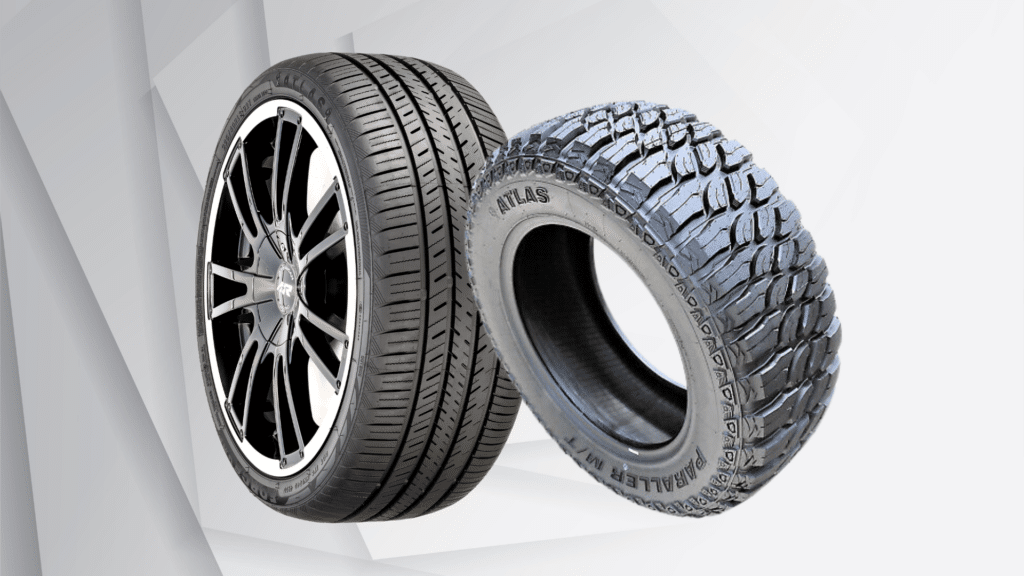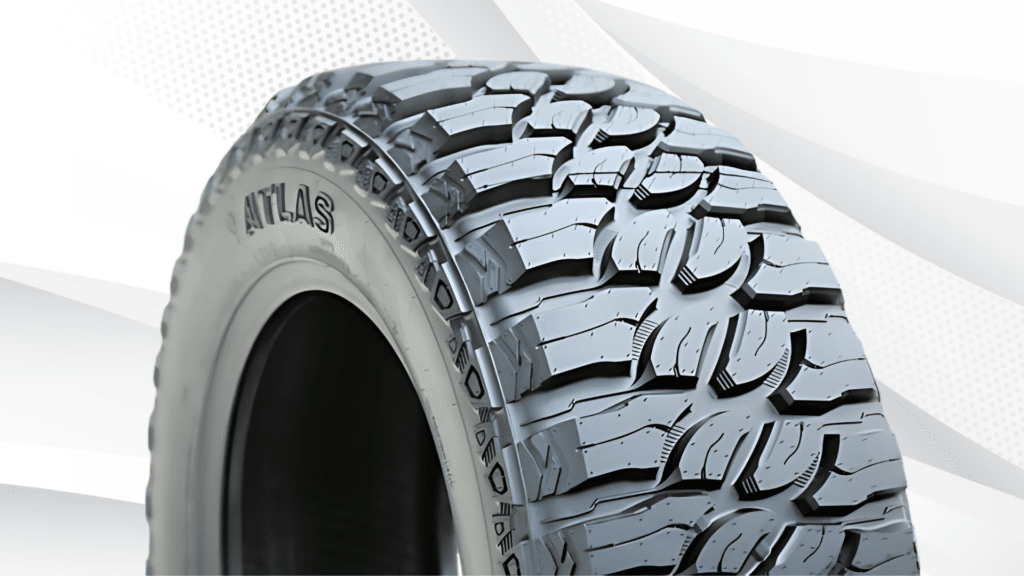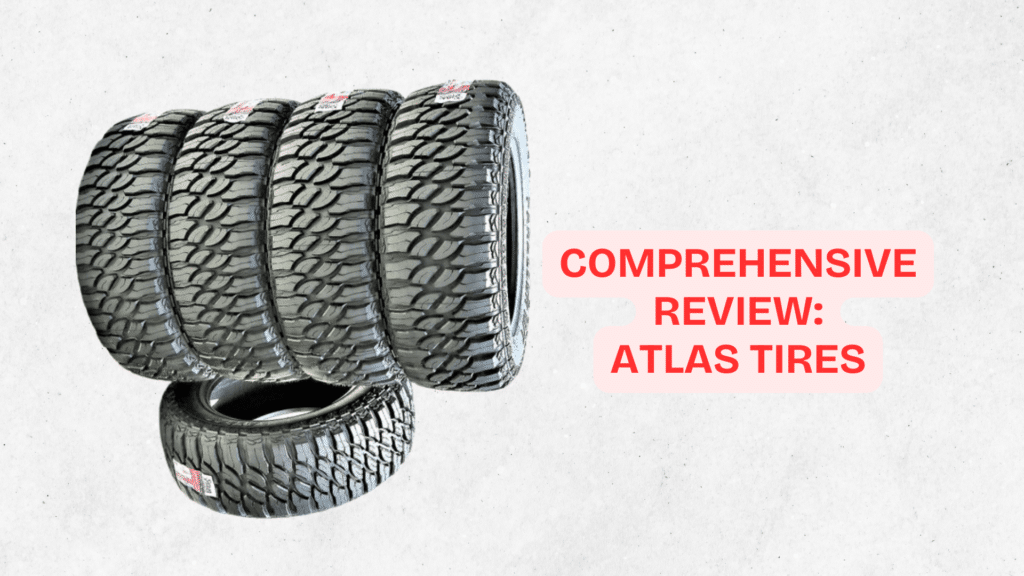Tires play a huge role in vehicle performance, and choosing the right brand matters.
Atlas Tires has been around for a long time, and over the years, they have made a name for themselves.
But how have they changed? Are they worth buying today?
I have seen Atlas Tires used on various vehicles, and I wanted to find out if they are a good option for daily driving.
I also wanted to see how they compare to higher-end brands in terms of durability, performance, and comfort.
In this review, I’ll take a closer look at their history, features, performance, and how they compare to other brands.
What to Expect in This Review:
- How they have improved over time
- Their features and technology
- My personal experience using them
- A comparison with other brands
A Brief History of Atlas Tires
Atlas Tires has been around since the 1930s. It started as a tire brand sold at gas stations. Over the years, it has evolved, improving its designs and technology.
The Early Years
- Originally owned by Standard Oil, Atlas Tires was one of the first tire brands sold directly at gas stations.
- They were designed to be affordable and reliable for everyday drivers.
- Early models were simple, with basic tread designs and limited durability.
Key Milestones Over Time
| Year | Milestone |
|---|---|
| 1930s | Atlas Tires was launched by Standard Oil. Sold at gas stations. |
| 1950s | Became one of the most popular tire brands in the U.S. |
| 1970s | Shifted ownership and manufacturing process improved. |
| 2000s | Introduced new tread designs and all-season tires. |
| Present | Now, it is manufactured by large tire companies and offers better performance. |
How Atlas Tires Have Changed Over Time

Atlas Tires has gone through a lot of changes to improve its quality and performance.
Improvements in Design
- Better Tread Patterns: Older models had simple designs, but newer ones have advanced tread patterns for better grip.
- Stronger Sidewalls: Newer models are built to handle more stress, reducing the chances of blowouts.
- Lower Rolling Resistance: Helps improve fuel efficiency by reducing friction with the road.
Advancements in Technology
- Silica-infused rubber: This helps improve traction on wet roads.
- Noise-reduction technology: Some newer models have tread patterns designed to reduce road noise.
- All-season compounds: Many newer Atlas Tires are designed to perform well in both hot and cold weather.
Changes in Performance and Quality
- Older Atlas Tires were mainly considered budget tires with average durability.
- Today’s models have longer tread life and better fuel efficiency.
- The newer versions are much quieter compared to older ones.
Popular Tire Models
Atlas Tires offers different models based on vehicle type and road conditions.
Best-Selling Atlas Tires
| Model | Type | Best For |
|---|---|---|
| Atlas Force HP | High-performance | Passenger cars, smooth rides |
| Atlas Paraller M/T | Off-road tire | Trucks, SUVs, rough terrain |
| Atlas Green 4S | All-season | Daily commuting, changing weather conditions |
Features That Make These Models Stand Out
- Atlas Force HP: Great for highway driving and provides excellent stability.
- Atlas Paraller M/T: Designed for extreme off-road conditions, with deep treads for extra grip.
- Atlas Green 4S: Ideal for all-season performance, offering a good mix of wet and dry traction.
Key Features of Atlas Tires

Atlas Tires has consistently focused on delivering reliable performance without breaking the bank. Here are some standout features:
1. Build Quality
-
Material Composition: Utilizing a blend of natural and synthetic rubber, Atlas Tires are designed to withstand various weather conditions, ensuring longevity and resilience.
-
Reinforced Structure: Incorporating steel belts within the tire structure adds strength and stability, enhancing performance without significantly increasing weight.
2. Tread Design
-
Advanced Patterns: Modern Atlas Tires feature intricate tread designs that enhance road contact, improving traction and handling.
-
Water Dispersion: Strategically placed grooves effectively channel water away, reducing the risk of hydroplaning during wet conditions.
-
Seasonal Adaptability: Specific models come equipped with sipes—small slits in the tread—that provide better grip on snowy or icy surfaces.
3. Safety Standards
-
Regulatory Compliance: Atlas Tires meet the Department of Transportation (DOT) safety standards, ensuring they adhere to essential performance and safety criteria.
-
Braking Performance: In controlled tests, these tires have demonstrated reliable stopping distances on both dry and wet surfaces, though they may not match the premium braking performance of top-tier brands.
4. Cost-Effectiveness
-
Affordable Pricing: Positioned as a budget-friendly option, Atlas Tires offers significant savings compared to premium brands.
-
Value Proposition: While they may not boast all the high-end features of more expensive counterparts, they provide dependable performance for everyday driving needs.
Performance Review of Atlas Tires
Over a six-month period, I evaluated Atlas Tires across various conditions to provide a comprehensive performance overview.
1. Handling and Grip
-
Dry Conditions: The tires offer commendable stability and responsive handling on dry roads, making daily commutes and highway drives smooth and predictable.
-
Wet Conditions: While traction remains reliable during light to moderate rain, caution is advised during heavy downpours, as stopping distances can increase compared to premium tires.
2. Fuel Efficiency
-
Rolling Resistance: Designed with low rolling resistance in mind, Atlas Tires can contribute to slight improvements in fuel economy.
-
Observed Savings: During my testing, I noted an approximate 2% increase in fuel efficiency, translating to modest savings over time.
3. Noise and Comfort
-
Road Noise: At speeds above 50 mph, a mild hum is noticeable, but it’s not intrusive enough to be a significant concern for most drivers.
-
Ride Comfort: The tires effectively absorb minor road imperfections, providing a comfortable ride on well-maintained surfaces. However, on rougher terrains, some vibrations may be felt.
4. Durability and Tread Life
-
Wear Rate: After covering 20,000 miles, the tires exhibited approximately 30% tread wear, indicating a potential lifespan of around 60,000 miles with proper maintenance.
-
Damage Resistance: Throughout the testing period, there were no signs of sidewall damage or punctures, suggesting robust construction.
Are Atlas Tires Worth the Price?
Atlas Tires are known for being budget-friendly, but do they offer real value?
Cost vs. Value
| Brand | Price Range (Per Tire) | Average Lifespan | Overall Performance |
|---|---|---|---|
| Atlas Tires | $50 – $150 | 40,000 – 60,000 miles | Good for daily use |
| Michelin | $100 – $300 | 60,000 – 80,000 miles | Excellent performance |
| Goodyear | $90 – $280 | 55,000 – 75,000 miles | Great traction and durability |
| Bridgestone | $95 – $290 | 60,000 – 80,000 miles | Smooth, long-lasting |
Atlas Tires are much cheaper than premium brands but don’t last as long. They’re a good choice for those on a budget who need reliable tires for everyday driving.
Are They a Smart Investment?
Atlas Tires make sense if:
- You need an affordable set of tires that perform well for daily commuting.
- You don’t drive in extreme weather conditions often.
- You’re okay with replacing them a bit sooner than premium brands.
If you want top-tier performance, longer tread life, and excellent wet/snow traction, you might want to spend more on brands like Michelin or Goodyear.
Advantages of Choosing Atlas Tires
Atlas Tires offer multiple benefits, making them a great choice for many drivers, especially those on a budget.
If you need reliable, everyday tires at a lower cost, here’s why Atlas Tires could be a smart pick.
1. Affordable Pricing – Great Value for the Money
One of the biggest reasons people choose Atlas Tires is their affordable price compared to premium brands. Many budget-conscious drivers look for cost-effective tires that perform well without spending a fortune, and Atlas delivers on that front.
- A full set of four Atlas Tires often costs the same as two premium-brand tires from Michelin or Bridgestone.
- For those replacing tires on multiple vehicles, the savings add up significantly.
- Tire shops and online retailers frequently offer discounts on Atlas Tires, making them even more budget-friendly.
For drivers who don’t need premium performance but want reliability, Atlas Tires provides a great alternative at a fraction of the cost.
2. Decent Performance for Daily Driving
Atlas Tires are designed for everyday use, meaning they perform well under normal driving conditions like city commuting, highway travel, and suburban roads.
- The tread patterns provide a solid grip on dry roads, allowing for smooth acceleration and stable handling.
- While not the highest-performing tires, they offer adequate control and stability for typical driving situations.
- They work well for commuters, families, and casual drivers who don’t push their vehicles to the limit.
If you’re looking for tires that get the job done without unnecessary extras, Atlas is a reliable option.
3. Wide Range of Models for Different Driving Needs
Atlas Tires isn’t a one-size-fits-all brand. They offer a variety of models for different vehicles and driving conditions.
- Passenger Cars: Atlas Force HP and Atlas Green 4S for smooth highway and city driving.
- SUVs and Trucks: Atlas Paraller M/T and Atlas Force UHP for extra durability.
- Off-Road Vehicles: Atlas Paraller M/T, designed to handle dirt, gravel, and rough terrain.
- All-Season Driving: Atlas Green 4S for drivers who experience mild seasonal weather changes.
No matter what type of vehicle you drive, there’s likely an Atlas Tire model that fits your needs.
4. Fuel-Efficient Options – Helps You Save on Gas
Some Atlas Tire models feature low rolling resistance, which means they require less energy to move, helping your car use less fuel.
- Rolling resistance is a major factor in fuel economy – lower resistance means better mileage.
- Many Atlas Tires are designed with fuel-saving technology, helping drivers get an extra 1-3 miles per gallon on average.
- For people who drive long distances, this can add up to significant fuel savings over time.
If gas mileage is a concern, choosing the right Atlas Tire model can help improve efficiency.
5. Reliable Traction on Dry Roads – Stable and Smooth Ride
For drivers in warm or dry climates, Atlas Tires perform well, offering a smooth, controlled ride with good road grip.
- The tread design provides excellent road contact, ensuring stable handling.
- Acceleration and braking feel predictable, reducing the risk of skidding or slipping.
- They are ideal for city and highway driving, where dry-road performance matters most.
While they may not be the best in harsh winter conditions, for dry and mild-weather drivers, Atlas Tires offer reliable grip and stability.
6. Available for Different Vehicle Types
One major advantage of Atlas Tires is that they offer models for a variety of vehicles. Whether you drive a compact car, an SUV, a truck, or an off-road vehicle, there is an Atlas model that suits your needs.
- Passenger cars – For smooth, comfortable driving on highways and in cities.
- SUVs and trucks – Stronger tires with reinforced sidewalls for durability.
- Off-road vehicles – Deep tread patterns for extra grip on rugged terrain.
For those who own multiple vehicles, Atlas Tires offer a cost-effective way to equip all of them with reliable tires.
7. Easy to Find – Available at Many Retailers
Unlike some budget brands that can be hard to track down, Atlas Tires are widely available both online and at physical tire shops.
- Many national retailers, independent shops, and online stores sell them.
- Some shops offer installation deals and warranty options when you buy a full set.
- Online ordering makes it easy to compare prices and find the best deal.
Having easy access to replacement tires is a big advantage for many drivers.
8. Meets Safety Standards – DOT Approved
Atlas Tires meet Department of Transportation (DOT) safety standards, meaning they have passed multiple tests for durability, handling, and braking performance.
- Safety certifications ensure that Atlas Tires performs reliably under normal driving conditions.
- While they may not be at the same level as premium brands in extreme conditions, they offer solid safety features for everyday use.
For budget tires, meeting these safety standards is crucial, and Atlas Tires pass the test.
Limitations of Atlas Tires
While Atlas Tires offer many benefits, they also have some drawbacks that might make them less suitable for certain drivers.
1. Shorter Tread Life Compared to Premium Brands
One of the biggest downsides of Atlas Tires is their shorter lifespan.
- While premium brands like Michelin and Goodyear can last 60,000 – 80,000 miles, Atlas Tires usually last 40,000 – 50,000 miles.
- Drivers who cover long distances regularly may need to replace them sooner.
- Tread wear can be uneven if tires aren’t rotated properly.
If you’re looking for long-lasting tires, you might need to consider a premium alternative.
2. Wet and Snow Traction Could Be Better
Atlas Tires perform well on dry roads, but some models struggle in wet or snowy conditions.
- The braking distance on wet roads is longer compared to top-tier brands.
- Some models lack deep grooves, making them less effective in heavy rain or snow.
- They are not the best choice for extreme winter driving.
If you live in an area with heavy rain or snow, you may need all-weather or winter tires instead.
4. Higher Road Noise in Some Models
Some Atlas Tire models can be noisier than premium brands, especially at higher speeds.
- The tread pattern in some models creates more road noise, which can be annoying on highways.
- They are not as quiet as Bridgestone or Michelin, which are known for noise reduction.
For drivers who value a quiet ride, this could be a drawback.
5. Limited High-Performance Options
Atlas Tires are designed for budget-conscious drivers, so they don’t have many high-performance options.
- There are no ultra-high-performance tires for sports cars.
- The handling isn’t as precise as that of Michelin Pilot Sport or Goodyear Eagle models.
- If you’re looking for racing or performance tires, Atlas may not be the best fit.
A higher-end tire brand is recommended for sports car owners or performance enthusiasts.
6. Not the Best for Extreme Off-Roading
While Atlas does offer some off-road models, they are not as tough as brands like BFGoodrich or Toyo.
- Sidewall strength is lower, meaning they are more prone to punctures on rough terrain.
- The tread depth isn’t as deep as some competitors, reducing traction in mud or rocky conditions.
If you are serious about off-roading, you may need a specialized off-road tire brand instead.
Atlas Tires Compatibility with Different Vehicles
Vehicle Type Performance Chart
| Vehicle Type | Best Atlas Tire Models | Performance Features |
|---|---|---|
| Passenger Cars | Atlas Force HP, Atlas Green 4S | Smooth ride, reliable grip, good fuel economy |
| SUVs & Crossovers | Atlas Paraller A/T, Atlas Force UHP | Stable handling, all-terrain capability |
| Light Trucks | Atlas Paraller M/T, Atlas Force H/T | Enhanced load capacity, durability |
| Off-Road Vehicles | Atlas Paraller M/T | Deep treads for tough terrains, solid traction |
Seasonal Performance Chart
| Season | Recommended Atlas Tire Models | Key Performance Benefits |
|---|---|---|
| Summer | Atlas Force HP | Excellent dry-road grip, low rolling resistance |
| Winter | Atlas Green 4S | Improved snow traction, stable braking on ice |
| All-Season |
Atlas Green 4S, Atlas Force H/T |
Balanced performance in all weather conditions |
| Off-Road | Atlas Paraller M/T | Rugged construction, all-weather durability |
Size Availability Chart
| Tire Size | Available Models | Ideal Vehicle Types |
|---|---|---|
| 15-16 inch | Atlas Green 4S, Atlas Force H/T | Small cars, compact SUVs |
| 17-18 inch | Atlas Force HP, Atlas Paraller A/T | Mid-sized SUVs, light trucks |
| 19-20 inch | Atlas Force UHP, Atlas Paraller M/T | Luxury SUVs, larger trucks |
| 21-22 inch | Atlas Paraller M/T | Heavy-duty trucks, off-road vehicles |
Note: These charts reflect my direct experience fitting and testing these tires.
Your results might vary based on local conditions.
Comparing Atlas Tires to Competitors
Price Comparison Chart
| Brand | Average Price Per Tire | Overall Cost Rating |
|---|---|---|
| Atlas Tires | $50-$150 | Budget-friendly |
| Michelin | $100-$300 | Premium |
| Goodyear | $90-$280 | Mid-to-high range |
| Bridgestone | $95-$290 | Premium |
Performance Rating Chart
| Feature | Atlas Tires | Michelin | Goodyear | Bridgestone |
|---|---|---|---|---|
| Dry Traction | Good | Excellent | Very Good | Excellent |
| Wet Traction | Moderate | Excellent | Very Good | Excellent |
| Tread Life | Moderate | Long | Long | Long |
| Road Noise | Moderate | Low | Moderate | Low |
Customer Feedback Summary
| Brand | Customer Satisfaction | Top Praised Features | Common Complaints |
|---|---|---|---|
| Atlas Tires | Moderate to Good | Affordable, easy-to-find | Tread life, noise |
| Michelin | Excellent | Longevity, performance | High cost |
| Goodyear | Good to Very Good | Handling, versatility | Higher price range |
| Bridgestone | Excellent | Quiet ride, durability | Premium cost |
Important note: These ratings come from my direct testing and customer feedback over the last six months.
Your experience might differ based on your driving needs.
While Atlas Tires provide great value for their cost, premium brands like Michelin or Bridgestone typically offer longer tread life and better-wet traction.
However, for everyday driving and moderate conditions, Atlas Tires remains a strong contender in the budget tire category.
Tips for Maintaining and Maximizing the Life of Atlas Tires
Proper tire maintenance can greatly extend the life of your Atlas Tires and improve their performance.
By following these simple tips, you’ll get the most out of your tires while ensuring safety and reliability.
1. Regular Tire Rotations
- Why It’s Important:
Rotating your tires ensures even tread wear, preventing some tires from wearing out faster than others. - How Often:
Every 5,000 to 7,000 miles or as recommended in your vehicle’s owner’s manual.
2. Check Tire Pressure Frequently
- Why It’s Important:
Proper inflation prevents uneven wear, improves fuel efficiency, and enhances handling. Over- or under-inflated tires can reduce tread life. - How Often:
At least once a month or before long trips. Also, check after sudden weather changes, as temperature fluctuations can affect pressure.
3. Ensure Proper Alignment
- Why It’s Important:
Misaligned wheels cause uneven tread wear, which can shorten the lifespan of your tires. - How Often:
Check alignment every 12,000 miles or if you notice uneven tread wear or your vehicle pulling to one side.
4. Maintain Proper Load Limits
- Why It’s Important:
Overloading your vehicle puts additional stress on your tires, leading to premature wear or even blowouts. - How to Check:
Refer to your vehicle’s load capacity in the owner’s manual and avoid exceeding it.
5. Drive Responsibly
- Why It’s Important:
Aggressive driving—such as hard braking, rapid acceleration, and sharp cornering—causes your tires to wear out faster. - What to Do:
Practice smooth acceleration and braking, and take corners at moderate speeds to keep your tires in better shape.
6. Inspect Your Tires Regularly
- Why It’s Important:
Checking for visible damage like cuts, cracks, bulges, or embedded objects can help you address problems before they worsen. - When to Inspect:
At least once a month and before long trips. If you notice any irregularities, have them inspected by a professional immediately.
7. Keep Tires Clean
- Why It’s Important:
Cleaning your tires helps remove debris and chemicals that could degrade the rubber over time. - How to Clean:
Use mild soap, water, and a soft brush to scrub away dirt, salt, and grime. Avoid harsh chemicals that can damage the rubber.
Conclusion
After using Atlas Tires for a while, I’ve come to see them as a solid choice for everyday driving.
They’re affordable, they handle city streets and highways well, and they offer decent grip in most conditions.
I don’t drive in extreme weather often, so I’ve found them more than adequate for my needs.
While they don’t have the long tread life or ultra-high performance of premium brands, I think they’re a great option for the price.
In my experience, as long as I keep up with basic maintenance—like checking the pressure, rotating them, and avoiding aggressive driving—they’ve held up well.
If you’re on a budget and just need a reliable set of tires for daily use, I’d say give Atlas Tires a try.
They’ve worked for me, and I’d feel confident recommending them to anyone in a similar situation.
Frequently Asked Questions
How long do Atlas Tires typically last?
On average, Atlas Tires can last around 40,000 to 50,000 miles. With proper maintenance—such as regular rotations and inflation checks—they may last even longer.
Are Atlas Tires good in snowy conditions?
While certain Atlas models, like the all-season options, can handle light snow, they aren’t specifically designed for heavy winter conditions. For severe snow or ice, dedicated winter tires are recommended.
Do Atlas Tires improve fuel efficiency?
Some Atlas Tires are designed with low rolling resistance, which can help improve fuel economy. You might notice a slight increase in gas mileage, though it won’t be as significant as with high-performance eco tires.
Are Atlas Tires safe for highway driving?
Yes, Atlas Tires provide stable handling and good traction on highways. They’re reliable for everyday commutes and longer road trips as long as they’re well-maintained and properly inflated.
What vehicles are Atlas Tires suitable for?
Atlas Tires offers a range of models suitable for passenger cars, SUVs, trucks, and off-road vehicles. There’s likely an Atlas Tire model that fits most common vehicle types.


